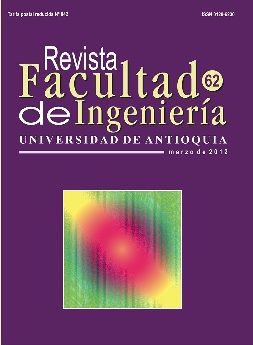A method for estimating the position and direction of a leader of a set of moving objects
DOI:
https://doi.org/10.17533/udea.redin.11777Keywords:
movement patterns, flocks, leadership, moving objectsAbstract
Movement patterns can be identified when studying a group of moving entities such as a group of people, a flock of birds, a school of fish, a convoy of vehicles, among others. In this paper, it is analyzed a pattern, known as leadership. Informally, this pattern is characterized by a moving entity called leader that motivates or represents the behavior of the group in order to reach a goal during a period. A formal method is proposed to estimate the position and the direction where a leader should be located and headed at a time-point in order to lead a group. These estimations can also be useful to check the consistency of the data about a leadership pattern, and to estimate the missing information (position and direction) of a leader at a specific time, i.e., an imputation process. In order to show the expediency of the proposal, a series of experiments were implemented and conducted using Netlogo, a programmable modeling environment for simulating natural and social phenomena.
Downloads
References
S. Dodge, R. Weibel, A. Lautenschuz. “Towards a Taxonomy of Movement Patterns”. Information Visualization. Vol. 7. 2008. pp. 240–252. DOI: https://doi.org/10.1057/PALGRAVE.IVS.9500182
M. Benkert, J. Gudmundsson, F. Hübner, T. Wolle. “Reporting Flock Patterns”. Lecture Notes in Computer Science. Vol. 4168. 2006. pp. 660-671. DOI: https://doi.org/10.1007/11841036_59
M. Andersson, J. Gudmundsson, P. Laube, T. Wolle. Reporting Leadership Patterns Among Trajectories. SAC: Symposium on Applied Computing. New York (USA). 2007. pp. 3-7. DOI: https://doi.org/10.1145/1244002.1244004
F. Moreno, E. Ospina. “On Estimating the Position and Direction of a Leader of a Group of Entities”. Mathematical Modelling in Engineering & Human Behaviour. Oral communication. Valencia. 2011. pp. 1-2.
L. Saul. Convoy Leader Training: Tactics, Techniques and Procedures. Center for Army Lessons Learned (CALL) Handbook. U.S. Army. 2003. pp. 1-81.
N. Farrington, H. Nguyen, N. Pezeshkian. Intelligent Behaviors for a Convoy of Indoor Mobile Robots Operating in Unknown Environments. SPIE: Mobile Robots XVII. Philadelphia. 2004. pp. 26-28. DOI: https://doi.org/10.1117/12.571527
A. Farhangfar, L. Kurgan, W. Pedrycks. “A Novel Framework for Imputation of Missing Values in Databases”. IEEE Transactions on Systems Man and Cybernetics. Vol. 37. 2007. pp. 692-709. DOI: https://doi.org/10.1109/TSMCA.2007.902631
M. Ian, D. Hoey. Geometric Intersection Problems. FOCS: Annual Symposium on Foundations of Computer Science. Houston. 1976. pp. 208-215.
C. Murray. Oracle Spatial. User’s Guide and Reference 10g. Release 2 (10.2). Ed. Oracle. 2006. pp. 29-46.
U. Wilensky. NetLogo Flocking Model. Center for Connected Learning and Computer-Based Modeling, Northwestern University. Disponile en:. http://ccl.northwestern.edu/netlogo/models/Flocking. Cosultado en Febrero 5 de 2011.
S. Momen, B. Amavasai, N. Siddique. Mixed Species Flocking for Heterogeneous Robotic Swarms. IEEE Eurocon: The International Conference on Computer as a Tool. Warsaw. 2007. pp. 2329 - 2336. DOI: https://doi.org/10.1109/EURCON.2007.4400455
F. Stonedahl, U. Wilensky. Finding Forms of Flocking: Evolutionary Search in ABM Parameter-Spaces. AAMAS: International Conference on Autonomous Agents and Multi-Agent Systems. Toronto. 2011. pp. 61-75. DOI: https://doi.org/10.1007/978-3-642-18345-4_5
W. Zongyao, G. Dongbing. Distributed Cohesion Control for Leader-follower Flocking. FUZZ-IEEE: IEEE International Conference on Fuzzy Systems. London. 2007. pp. 23-26.
S. Housheng, W. Xiaofan, L. Zongli. Flocking of Multiagents with a Virtual Leader Part I: With a Minority of Informed Agents. IEEE Conference on Decision and Control. New Orleans. 2007. pp. 2937-2942. DOI: https://doi.org/10.1109/CDC.2007.4434066
H. Su, G. Chen, X. Wang, Z. Lin. Adaptive Flocking with a Virtual Leader of Multiple Agents Governed by Nonlinear Dynamics. CCC: Chinese Control Conference. Beijing. 2010. pp. 29-31.
Downloads
Published
How to Cite
Issue
Section
License
Copyright (c) 2018 Revista Facultad de Ingeniería

This work is licensed under a Creative Commons Attribution-NonCommercial-ShareAlike 4.0 International License.
Revista Facultad de Ingeniería, Universidad de Antioquia is licensed under the Creative Commons Attribution BY-NC-SA 4.0 license. https://creativecommons.org/licenses/by-nc-sa/4.0/deed.en
You are free to:
Share — copy and redistribute the material in any medium or format
Adapt — remix, transform, and build upon the material
Under the following terms:
Attribution — You must give appropriate credit, provide a link to the license, and indicate if changes were made. You may do so in any reasonable manner, but not in any way that suggests the licensor endorses you or your use.
NonCommercial — You may not use the material for commercial purposes.
ShareAlike — If you remix, transform, or build upon the material, you must distribute your contributions under the same license as the original.
The material published in the journal can be distributed, copied and exhibited by third parties if the respective credits are given to the journal. No commercial benefit can be obtained and derivative works must be under the same license terms as the original work.










 Twitter
Twitter